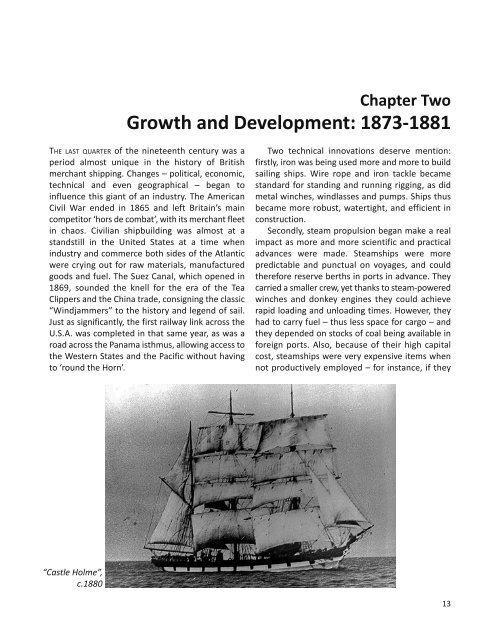A Cumberland Endeavour Sample
The story of Hine Brothers of Maryport, a shipping company founded and run by Wilfrid and Alfred Hine in the la er half of the nineteenth century. This book links the milestones in the company’s development to the important events in the lives of the brothers and their wider family; to the ships and the exploits of their captains and crews; and to Maryport itself, through the Victorian era un l just before the Great War.
The story of Hine Brothers of Maryport, a shipping company founded and run by Wilfrid and Alfred Hine in the la er half of the nineteenth century. This book links the milestones in the company’s development to the important events in the lives of the brothers and their wider family; to the ships and the exploits of their captains and crews; and to Maryport itself, through the Victorian era un l just before the Great War.
Create successful ePaper yourself
Turn your PDF publications into a flip-book with our unique Google optimized e-Paper software.
Chapter Two<br />
Growth and Development: 1873-1881<br />
THE LAST QUARTER of the nineteenth century was a<br />
period almost unique in the history of British<br />
merchant shipping. Changes – political, economic,<br />
technical and even geographical – began to<br />
influence this giant of an industry. The American<br />
Civil War ended in 1865 and left Britain’s main<br />
competitor ‘hors de combat’, with its merchant fleet<br />
in chaos. Civilian shipbuilding was almost at a<br />
standstill in the United States at a time when<br />
industry and commerce both sides of the Atlantic<br />
were crying out for raw materials, manufactured<br />
goods and fuel. The Suez Canal, which opened in<br />
1869, sounded the knell for the era of the Tea<br />
Clippers and the China trade, consigning the classic<br />
“Windjammers” to the history and legend of sail.<br />
Just as significantly, the first railway link across the<br />
U.S.A. was completed in that same year, as was a<br />
road across the Panama isthmus, allowing access to<br />
the Western States and the Pacific without having<br />
to ‘round the Horn’.<br />
Two technical innovations deserve mention:<br />
firstly, iron was being used more and more to build<br />
sailing ships. Wire rope and iron tackle became<br />
standard for standing and running rigging, as did<br />
metal winches, windlasses and pumps. Ships thus<br />
became more robust, watertight, and efficient in<br />
construction.<br />
Secondly, steam propulsion began make a real<br />
impact as more and more scientific and practical<br />
advances were made. Steamships were more<br />
predictable and punctual on voyages, and could<br />
therefore reserve berths in ports in advance. They<br />
carried a smaller crew, yet thanks to steam-powered<br />
winches and donkey engines they could achieve<br />
rapid loading and unloading times. However, they<br />
had to carry fuel – thus less space for cargo – and<br />
they depended on stocks of coal being available in<br />
foreign ports. Also, because of their high capital<br />
cost, steamships were very expensive items when<br />
not productively employed – for instance, if they<br />
“Castle Holme”,<br />
c.1880<br />
13



